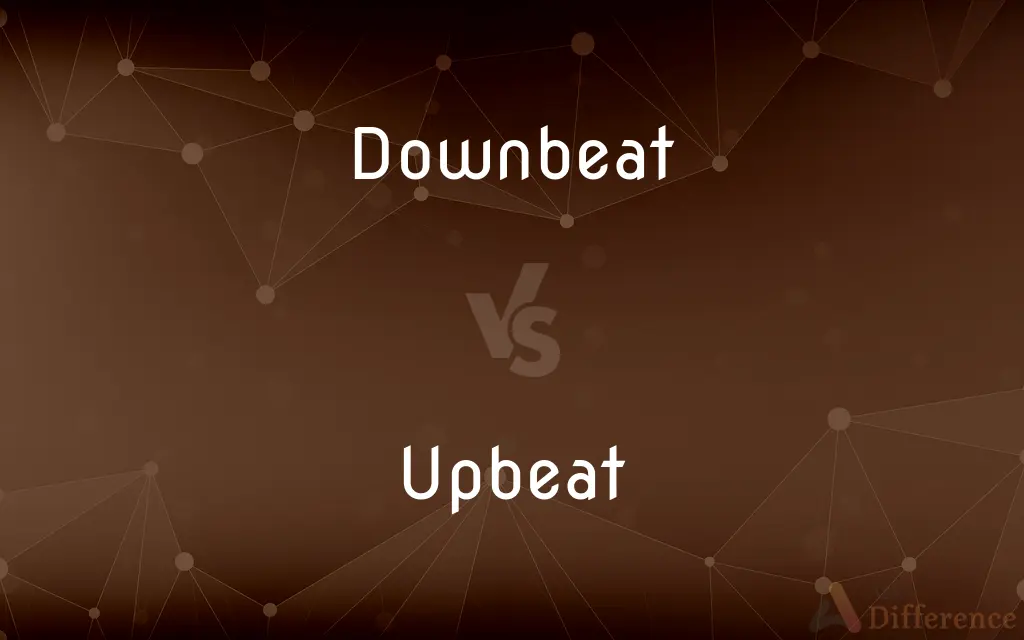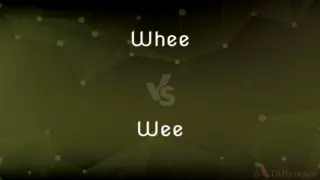Downbeat vs. Upbeat — What's the Difference?
By Fiza Rafique & Maham Liaqat — Updated on March 12, 2024
Downbeat is the first beat of a measure in music, often marked by greater accent, while upbeat is the last beat, leading into the next downbeat.

Difference Between Downbeat and Upbeat
Table of Contents
ADVERTISEMENT
Key Differences
The downbeat in music signifies the start of a measure and is usually emphasized, serving as a foundational beat that establishes the rhythm and tempo. On the other hand, the upbeat is the beat just before the downbeat, often lighter and serving as a preparatory cue for the downbeat, creating anticipation.
The downbeat represents strength and stability within the composition, often where chords and harmonies are resolved, providing a sense of completion. Conversely, the upbeat introduces movement and tension, suggesting continuation and leading into the next musical phrase or measure.
In conducting, the downbeat is typically indicated by a downward motion of the conductor's baton, symbolizing the beginning of a new measure. The upbeat, however, is shown with an upward motion, preparing the orchestra or ensemble for the coming downbeat.
The perception of downbeats and upbeats can deeply influence the feel of a piece. Downbeats are associated with more forceful, definitive moments in music, whereas upbeats can lend a piece a more dynamic, fluid character, often associated with dance and lighter passages.
The role of downbeats and upbeats extends beyond classical music, influencing genres like jazz, pop, and dance music. The upbeat is particularly significant in styles emphasizing syncopation and rhythm, where the anticipation and movement toward the downbeat drive the music's groove.
ADVERTISEMENT
Comparison Chart
Definition
The first beat of a measure, often emphasized
The last beat of a measure, leading into the first
Musical Role
Signifies strength and stability
Introduces movement and tension
Conducting Cue
Downward motion
Upward motion
Musical Impact
Provides a sense of completion
Suggests continuation, anticipation
Genre Influence
Central in all music genres
Critical in rhythm and dance-oriented styles
Compare with Definitions
Downbeat
Associated with stability.
Chords often resolve on the downbeat for a sense of closure.
Upbeat
Lends fluidity to music.
The song's upbeat tempo makes it perfect for dancing.
Downbeat
Provides musical completion.
The phrase ends strongly on the downbeat.
Upbeat
Introduces musical tension.
The melody’s upbeat creates anticipation for the next measure.
Downbeat
First beat of a measure.
The conductor emphasized the downbeat to signal the start of the piece.
Upbeat
Signifies musical anticipation.
The upbeat in the bridge adds excitement leading back to the verse.
Downbeat
Essential in rhythm establishment.
The downbeat anchors the rhythm section in jazz.
Upbeat
Beat before the downbeat.
The drummer's fill led smoothly into the upbeat before the chorus.
Downbeat
Marked by a downward conducting motion.
The downbeat is indicated by the conductor's baton moving downward.
Upbeat
Shown with an upward conducting motion.
The conductor's upbeat gesture prepared the orchestra.
Downbeat
The first beat of a measure.
Upbeat
(in music) an unaccented beat preceding an accented beat.
Downbeat
The downward stroke made by a conductor to indicate the first beat of a measure.
Upbeat
Cheerful; optimistic
He was upbeat about the company's future
Downbeat
Cheerless; pessimistic.
Upbeat
An unaccented beat or beats that occur before the first beat of a measure. Also called anacrusis, pickup.
Downbeat
(music) The accented beat at the beginning of a bar (indicated by a conductor with a downward stroke).
Upbeat
The upward stroke made by a conductor to indicate the beat that leads into a new measure.
Downbeat
Sad or pessimistic.
He sounded downbeat when asked about his future plans.
Upbeat
Optimistic
An upbeat business forecast.
Downbeat
Cautiously optimistic.
She carried herself with a quiet downbeat grace.
Upbeat
Happy; cheerful.
Downbeat
The first beat of a musical measure (as the conductor's arm moves downward).
Upbeat
Having a fast pace, tempo, or beat.
The notes are easy, but it's an upbeat tune and should be played fairly quickly.
Downbeat
The first beat of a musical measure (as the conductor's arm moves downward)
Upbeat
Having a positive, lively, or perky tone, attitude, etc.
Though he had bad news, he ended with an upbeat forecast for the future.
He sounded upbeat when I talked to him.
Upbeat
An unaccented beat at the start of a musical phrase.
The conductor said: I give you three beats for nothing and then you come in on the upbeat.
Upbeat
A contented state of being happy and healthy and prosperous;
The town was finally on the upbeat after our recent troubles
Upbeat
An unaccented beat (especially the last beat of a measure)
Upbeat
Pleasantly (even unrealistically) optimistic
Common Curiosities
How do downbeats and upbeats affect musical composition?
Downbeats provide a foundation and stability, while upbeats introduce anticipation and movement, together creating the dynamic flow of music.
Can a piece of music start on an upbeat?
Yes, many compositions start with an upbeat to create immediate momentum and lead into the first downbeat with anticipation.
What is the upbeat?
The upbeat is the last beat of a measure that leads into the downbeat of the next, associated with preparation and anticipation.
What is the downbeat?
The downbeat is the first, often emphasized beat of a measure in music, marking the start of the rhythmic cycle.
Why is the downbeat often emphasized?
Emphasizing the downbeat helps maintain the rhythm and provides a clear starting point for measures, aiding in coordination among musicians.
Do all music genres use downbeats and upbeats?
Yes, downbeats and upbeats are fundamental concepts across all music genres, though their usage and emphasis may vary.
Is the upbeat always lighter than the downbeat?
While traditionally lighter, the upbeat's emphasis can vary depending on the style and intention of the music, sometimes being used to create strong anticipatory effects.
How does the conductor indicate downbeats and upbeats?
Conductors use specific baton motions, downward for downbeats and upward for upbeats, to visually guide the ensemble through the music's rhythm.
How do musicians use the concept of downbeat and upbeat?
Musicians use these concepts to structure rhythm, create emphasis, and guide the phrasing and dynamics of a piece.
How do upbeats contribute to dance music?
In dance music, upbeats are crucial for creating syncopation and rhythm, making the music more dynamic and conducive to dancing.
Share Your Discovery

Previous Comparison
Whee vs. Wee
Next Comparison
Dolphin vs. PorpoiseAuthor Spotlight
Written by
Fiza RafiqueFiza Rafique is a skilled content writer at AskDifference.com, where she meticulously refines and enhances written pieces. Drawing from her vast editorial expertise, Fiza ensures clarity, accuracy, and precision in every article. Passionate about language, she continually seeks to elevate the quality of content for readers worldwide.
Co-written by
Maham Liaqat













































